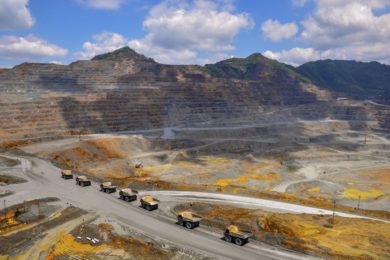The largest copper mine in China and one of Asia’s largest is Jiangxi Copper’s Dexing, which covers an area of more than 4,000 ha and has an annual output of more than 100,000 t, accounting for about a quarter of the country’s copper output at its peak. In late 2021 leading Chinese autonomous mining truck technology group TAGE Idriver and Jiangxi Copper signed an agreement to carry out unmanned transformation by retrofit of the in-service Komatsu and Chinese brand electric drive mining trucks and start unmanned driving. The deployment of software and hardware in the transportation system TAGE says will enable unmanned vehicles to interact with the other manned machines on the mine – electric shovels including the Komatsu P&H 2300XPC and Komatsu bulldozers for production operations.
Dexing’s relationship with Komatsu began in the 1980s with Komatsu-Dresser Haulpak 630E trucks followed by its current fleet of 730E and 830E units plus Chinese trucks which include MCC 400A and NHL NTE240A trucks plus in the past it used Euclid R190 and Hitachi EH3500 models. Dexing has previously stated that its decision to use Komatsu trucks is due to higher reliability and durability, which can ensure high availability; engine power, fast running speed, strong climbing ability, light and flexible steering, good fuel economy and strong resistance to dirt and moisture.
Jiangxi Copper has good reason to want to transition to autonomy. Dexing is located at the foot of Peacock Mountain in the Huaiyu Mountains, and nearly half of the days in a year are rainy. Summer is hot and rainy, followed by thick fog, humidity and a lot of standing water. The fact that it is rainy and foggy all the year round, means the visibility of vehicles is low, which affects the sustainability of mine production and production capacity compliance; plus after rain, the roads are slippery which is a headache especially when the vehicles are empty or driving downhill. While the driving skills of mining truck operators are high, their average age is relatively old and it is difficult to find new drivers to replace them.
TAGE says it and Jiangxi Copper will use unmanned driving technology to apply “tailor-made” solutions to the practical problems faced by Dexing one by one. Based on TAGE’s Kuanggu – loosely translated Unmanned Valley – automation platform, a full-stack solution for unmanned transportation in open-pit mines, it will implement unmanned transportation dispatching and command systems, high-precision positioning systems, roadside coordination systems, mine truck unmanned systems and collaborative operation systems. It will also be able to remotely take over the system and other aspects to provide technical services. In challenging weather, the dispatching system ensures safe operation through coordinated dispatching and speed control based on a high-precision map updated in real time.
All components have passed the vehicle-level testing and certification of the China Metrology Institute for the environment, electrical performance and electromagnetic compatibility, meeting official strict requirements for hardware to deal with vibration, humidity, plus high and low temperatures. Among them, the vehicle main controller has also passed the 3C certification and network access certification.
In China, there are still few studies on the comprehensive application of unmanned transportation systems in non-ferrous metal mines in difficuly weather and complex environments. “Through this cooperation, TAGe Idriver and Jiangxi Copper will jointly make breakthroughs on a number of key technologies in this scientific field, including key technologies for environmental perception of rainy, dense fog and accumulated water, precise control of vehicles on slippery roads and dynamic and intelligent boundary detection of dumps, which will greatly expand the boundaries of unmanned mine technology.”










